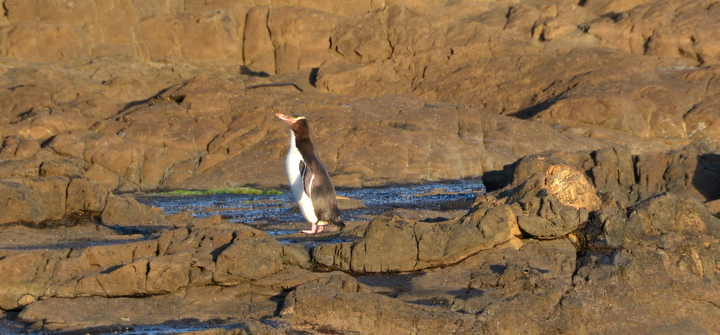• GPX file
• Profile
• Logbook
• Where are we?
Photo album:
• The Catlins
Recommended services:
• Fleurs Place restaurant
Did you find our website useful?
THANK YOU!
Leg breakdown:
Date Activity Leg Distance (Km) Elev. Gain (m) Elev. Desc. (m) 20-Feb-19 Riding Invercargill to Curio Bay 88.5 377 372 21-Feb-19 Riding Curio Bay to McLean falls 32.1 358 286 22-Feb-19 Riding McLean falls to Newhaven 59.1 698 788 23-Feb-19 Riding Newhaven to Kaka Point 22.1 186 175 24-Feb-19 Riding Kaka Point to Waihola 62.1 268 294 25-Feb-19 Riding Waihola to Dunedin 49.0 532 525 26-Feb-19 Riding Dunedin to Aramoana reserve 58.9 138 144 28-Feb-19 Riding Dunedin to Waikouaiti 51.2 640 641 1-Mar-19 Riding Waikouaiti to Moeraki 39.5 207 201 2-Mar-19 Riding Moeraki to Oamaru 44.0 218 219 Total 506.5 3622 3645
20 February - 2 March, 2019: The Catlins
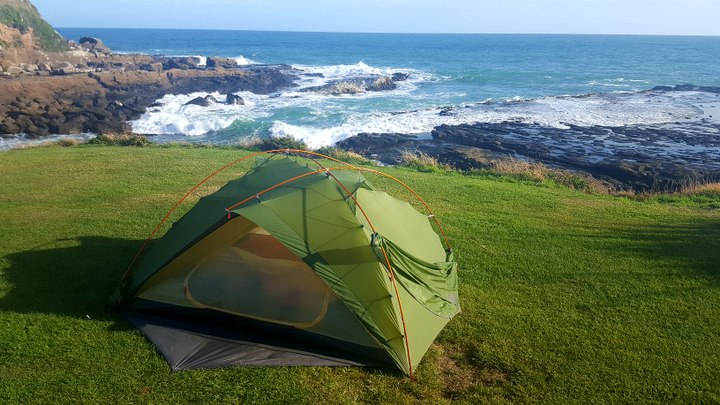
Everyone knows that The Catlins, the southeastern corner of the South Island, is a land of fables and myths. The elders of this land speak of eagles with 4 meters of wingspan that hunted moas, a species of ostrich that once roamed New Zealand. Paleontologists are in agreement that both species are extinct now. The current existence of kiwis in the wild (we refer to the birds) is a heated debate in New Zealand society. We know that it is a tourist trap and that they are actually extinct. But beside these last infamous birds and the prehistoric ones, there are other creatures that make The Catlins worth visiting. Or so we thought...
First of all, there are sea lions and seals. We have seen plenty of these and in good condition, meaning during the day and quite close. Seals have longer whiskers, they like rocky shores and climb on them in impossible ways. In particular, the seal species that inhabits this coast is the New Zealand fur seal. They spend hours and hours grooming their fur, secreting a substance from special glands and rubbing it all over the skin. They are especially funny when they rub their face with their two front flippers. On the other hand, sea lions prefer sandy beaches and apparently spend all day lying on them. In theory, they feed on fish and penguins, but we have always seen them sleeping on the beach. Actually, we believe that they feed by osmosis through the sand, but for the moment this theory has not been accepted or refuted by specialists in the field.
The other creatures of interest are the penguins. Its existence in the wild today is another topic of passionate discussions between tourists and tourism service providers. There are two species of penguins that supposedly use the coast of The Catlins to nest in summer: the yellow-eyed penguin and the blue penguin. The coast of any map of The Catlins is splashed with little penguin icons. The tourist guides recommend places and times to see them. Pamphlets from tourism companies show pictures of penguins a few meters away from euphoric tourists. Our conclusion after searching for them thoroughly in The Catlins is that they are extinct or in danger of extinction, as we will show in this story.
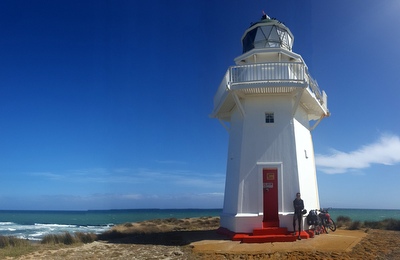 The Catlins is part of the New Zealand coast between Invercargill and Dunedin. In this story we also include the section between Dunedin and Oamaru, since in this area there are so many penguin icons on the maps that their wings touch. It is a cold, windy and rainy coast, with a climate as unpredictable as bad-tempered. The few trees that survive grow bent forced by the prevailing winds from the South, direct from Antarctica. The sea is always rough, except in the most protected coves between rocky headlands. The water has a cold color (we have not even dared to put the foot in). In several of the rocky bluffs there are lighthouses to alert the boats of the dangers of the coast. More than one was built after a catastrophic shipwreck. Our bike tour runs between fields dedicated to cows and sheep farming. The smooth rolling hills try to give a feeling of tranquility, but the shaking of the vegetation with the wind gusts reminds us that this is The Catlins, a hostile land. In contrast, the people who live here, especially the elderly, are super warm and welcoming. Perhaps because they know how hard life was in the past and still retain that hospitality towards the traveler, typical of inhospitable lands.
The Catlins is part of the New Zealand coast between Invercargill and Dunedin. In this story we also include the section between Dunedin and Oamaru, since in this area there are so many penguin icons on the maps that their wings touch. It is a cold, windy and rainy coast, with a climate as unpredictable as bad-tempered. The few trees that survive grow bent forced by the prevailing winds from the South, direct from Antarctica. The sea is always rough, except in the most protected coves between rocky headlands. The water has a cold color (we have not even dared to put the foot in). In several of the rocky bluffs there are lighthouses to alert the boats of the dangers of the coast. More than one was built after a catastrophic shipwreck. Our bike tour runs between fields dedicated to cows and sheep farming. The smooth rolling hills try to give a feeling of tranquility, but the shaking of the vegetation with the wind gusts reminds us that this is The Catlins, a hostile land. In contrast, the people who live here, especially the elderly, are super warm and welcoming. Perhaps because they know how hard life was in the past and still retain that hospitality towards the traveler, typical of inhospitable lands.
But let's not stray further from the topic that concerns us: the existence or not of penguins in The Catlins. Our first attempt at spotting them is in the lighthouse of Waipapa, a shortened version of its real name Waipapapa (even the Maoris thought that such repetition was excessive). On the beach we spot a couple of sea lions. It seems they are alive, but if they were dead we would not notice. Here the only birds we see fly. Therefore we discard the presence of penguins. We continue on, towards Curio Bay, our first night in The Catlins. Curio Bay is famous for its yellow-eyed penguin colony. The chiefs of the land say that the froth created by the hordes of penguins returning to land at sunset could be seen miles away from the coast. The young penguins formed a line in front of the raft and generated their own wave. The weakest members of the raft could surf the wave to save energy. We are in the right place and at the right time. A rope between the cliff and the water delimits the sighting area for tourists, about fifty at sunset. We have privileged information from someone who has recommended us the next cove over, where there is no rope and we can see them closer. We wait patiently in silence.
When the sun sets behind the cliff and we begin to get cold, we look out to the area where the other tourists wait and it seems that there is some activity there. We ask the two girls who control the tourists. It turns out that this year only one yellow-eyed penguin has showed up! Only one! And according to them, it is hidden behind a rock near the shore. Come on! This is a joke! When our hopes were crumbling, they point towards the rock stating that the penguin has appeared. On the rock, about 60 meters away, we can see a black and white shape. It could be a cardboard prop. Wait, it's moving its wings. Well, it could be a cardboard prop with articulated wings, connected to the body with loose rivets. Maybe they are moving with the wind like those parrot spinners used to scare off pigeons and gulls. Mmmm, it seems it’s walking. Awkwardly, but the penguins do it that way. The clumsy jumps to go down the rock convince us that it is a real penguin. Looking through the lens of the camera we can discern the yellow feathers that go from the eye, also yellow, backwards. The poor penguin looks towards the sea, waiting for some delayed friend to appear. He takes a few more jumps down from his vantage point and looks back again. Disappointed, he resumes his way to the cliff. Who knows, maybe he has even built a nest. Ignoring all the tourists, he keeps his head down on his way to his empty nest. A sad scene. However, we have to admit that we were wrong, the yellow-eyed penguin is not extinct. Yet, but this colony will be soon.
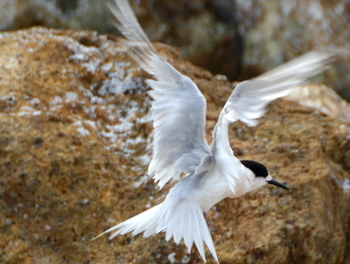
Happy with having seen at least one yellow-eyed penguin a few days ago, we focus our efforts on the blue penguins. These are smaller (25 cm) and return to the coast at nightfall, which makes them even harder to spot. We spent another night in Moeraki, north of Dunedin. On the other side of the bluff next to the fishing port there is a little beach that looks like a paradise for blue penguins. The seaweed covers the last stretch to the shore, perfect to fool a possible hungry seal. The distance between the water and the cliffs is short, perfect to dart to the underground nest, in case they have not confused the seal. Tonight we are spotting blue penguins here for sure. The sun already set some time ago but we continue to scrutinize any movement on the beach. Something is moving at a medium-far distance. It is a small animal, about 5 meters from the water, halfway to the cliffs. Wow, there are three of them! They are dark with a white spot, but the white spot seems to be located at the end of the back. We focus the camera zoom and they turn out to be rabbits!!!!! What the hell are three rabbits doing on the beach at 9 o'clock at night??? Hey, look over there! That has to be a penguin. White belly, black back, webbed feet, walks clumsily... But that elongated neck and hooked beak do not belong to penguins. It’s either a shag or a penguin disguised as a shag. It disappears behind a rock and we don’t see him again. Perhaps, once in private, he is removing the shag costume to start feeding his chicks. Maybe the rabbits were blue penguins disguised as rabbits. At this time it is so dark that even the stones look like penguins.
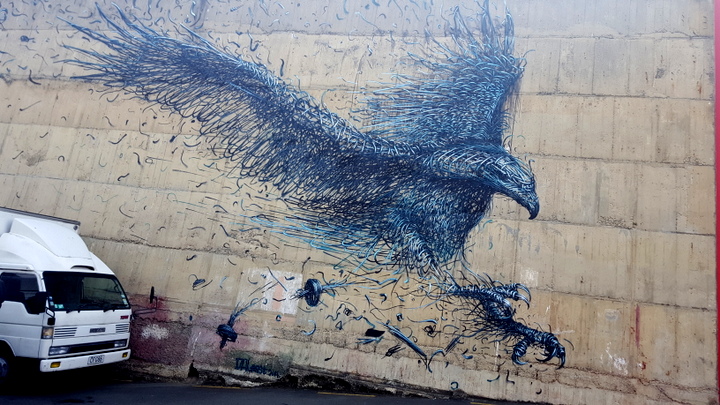
We are already desperate. Our last chance is the blue penguin colony in Oamaru. To see them you have to pay but we have agreed. They don’t even let you take pictures. Maybe they are holograms that cannot be captured with the cameras... When we arrive at the campground in Oamaru, always looking for local knowledge, we ask the receptionist for opportunities to spot the blue penguins. Her answer leaves us shocked: "There is a nest of blue penguins under the kitchen deck. The chick leaves the nest at 9:30 PM and the mother arrives around 11 PM. He is the last chick of this season in the campsite. Surely in 2 or 3 days he will leave the nest definitively". We quickly cancel the tour and reorganized the afternoon and evening around this great event. At 9 PM we sit in the front row with a bunch of other campers. About nine-fifteen, the receptionist comes by the kitchen, removes a rock located next to the staircase that goes up to the kitchen deck and leaves. A little weird, but we are too excited to think about it. After a little while, when it’s already dark, where the stone was, a fluffy ball with a beak comes out. We cannot believe our eyes. The ball begins to move awkwardly towards the edge of the deck and performs a penguin-type jump to the grass below. Amazing. It’s so dark that it could be a fuchsia penguin and we would not notice the difference, but that does not matter now. The chick approaches the edge of the lawn, delimited by a row of stones. When one of the spectators makes a noise, he gets scared and scoots back and hides under the deck. When the outside world calms down, he comes out again. As always happens in these occasions, there is an idiot that doesn’t mind ruining the night to the rest of spectators. Tonight is a kid of about 4 years. Well, more than the kids fault, it's the mother's. First she sits in front of us as if she was transparent. Luckily she moves away before we have to tell her something. Worst of all, the kid is holding a stuffed kiwi in his arms and his mother tells him it’s a penguin. What atrocity! Not only she buys him an extinct stuffed animal, but she also wants to make the child believe that it’s a penguin dressed as a kiwi. Of course, the child does not stop talking, singing, moving. Why doesn’t she take him to the caravan and sits him in front of the tablet? Since they have arrived, the chick has been hidden. When we are close to the boiling point, the kid squeezes the damn stuffed animal and it begins to play the call of the kiwi. Cèsar's hands move closer to the kid’s neck with the fingers twitching and the retractable claws out. Just before closing around his delicate little neck, the penguin chick comes out of under the deck and cautiously approaches the child. Well, it actually comes close to the stuffed kiwi. Oh my God! The entire existence of the blue penguin species depends on this chick and now he believes that his mother is a stuffed kiwi. Surely this will create a childhood trauma and when he is older he will disguise himself as a kiwi. Finally, after a while, the real mother of the penguin arrives, wobbling through the entrance of the campground like any other tourist. When the chick realizes that this time it’s his biological mother, he dashes towards her and begins to bang his head on her belly to make her regurgitate his dinner. Between hits, he screams and begs for the fish and squid she brings. The mother does not respond. It does not surprise us. With all that audience watching her, what mother would start vomiting dinner to her baby? Finally she gets under the deck. The chick follows her without stopping crying for his ration and the show is over. The spectators take the chairs, begin discussing about the event and retire to their caravans. We are pleased to be able to ensure that the blue penguins are not extinct yet either.
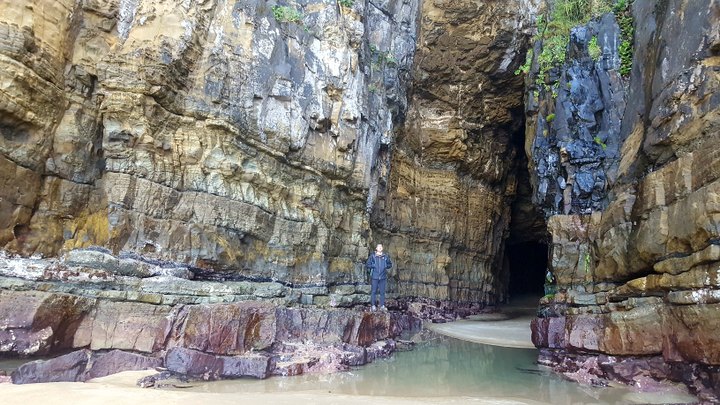
We also go to bed. For some reason, Cèsar cannot fall asleep. He cannot retract his claws and his hands remain rigid in a semi-closed position, as if they could not complete a task that seemed to be just and necessary. Judit keeps thinking about the rock that the receptionist moved away before the show started. Is that penguin a prisoner of the receptionist? Is she exploiting him to promote her campground? Is the mother coming to see her chick during prison visiting hours?
We've spent about ten days riding The Catlins. Some of the stories we have heard about the local fauna are already legends. Some of the experiences we have had, unfortunately, will soon be myths as well.
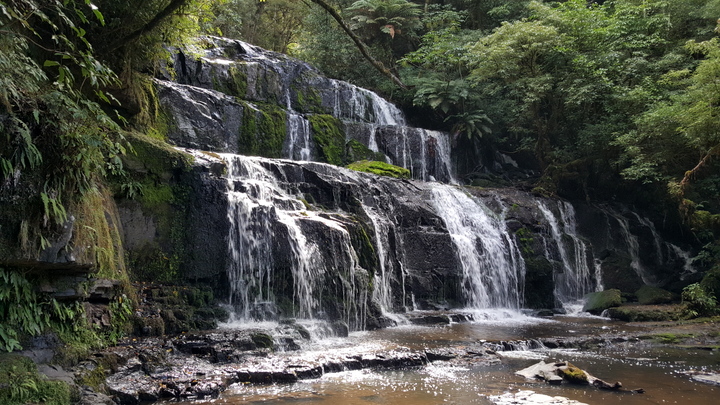
© 2018 Explore Pangea. All Rights Reserved. Website Terms of Use.
